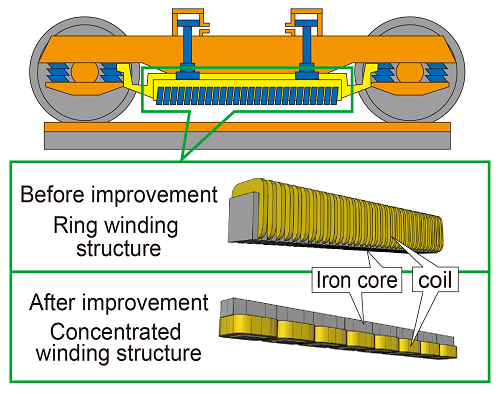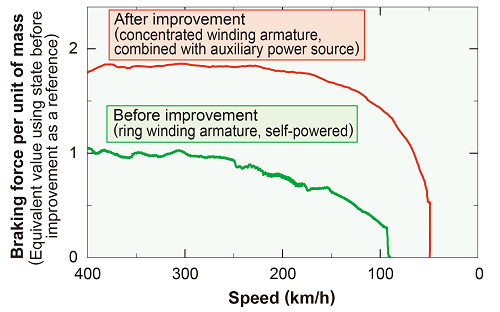23. Method for increasing braking force of linear rail brakes
In order to reduce the stopping distance of trains operating at high speed, a method for increasing the braking force of a linear rail brake equipped with an alternating current electromagnet (armature) has been developed.
The linear rail brake operates in the same way as the eddy current rail brake, where electromagnetic interaction between the armature and the rail generates a braking force. However, with the new device, since the energy needed for it to work is generated by the device itself, it can operate even when power is lost, and because of this feature, is also able to control any rise in rail temperature.
In the existing (previous) designs, ring winding electromagnets were used in order to control rail temperature (Fig. 1), however, this meant that there was a limit to the possible increase in braking force, and reduction of weight.
Therefore, based on a premise of using fewer devices on a trainset in order to avoid rail overheating, a method was designed that would increase the braking force of each individual device.
The new proposed design has a concentrated winding armature (Fig. 1) and a battery-operated backup auxiliary power source to enable it to function even with loss of power.
With the concentrated winding structure, by superimposition of distortion onto the sinusoid magnetic field on the rail generated by the armature, even though the maximum rail temperature increase is greater by a factor of 1.8 at the maximum running speed of the Shinkansen compared to the ring structure, the braking force can be raised by a factor of about 1.5.
When the uninterruptible auxiliary power backup was added to the device combined with the energizing system to reinforce the braking force, tests on the prototype armature demonstrated that the braking force could be increased by a factor of 1.9, compared to when the device was only self-powered (Fig. 2).
Based on this method, if the braking function of the trainset is maintained, the number of linear rail braking devices and the additional weight can be reduced by about half.
Nevertheless, given that the rail temperature rises by a factor of approximately 1.3, it is being considered for use in emergencies.
Estimations suggest that the rail temperature increase would be higher by approximately 1.8 ℃, under the condition that the stopping distance using the new linear rail brakes was be about 10% shorter than using disc brakes alone, and assuming the longest Shinkansen train formation being braked from the maximum running speed.
Other Contents
- 21. Vertical vibration control method for Shinkansen rolling stock
- 22. Aerodynamic brake design for higher Shinkansen running speeds
- 23. Method for increasing braking force of linear rail brakes
- 24. Development of a CPS contact wire for Shinkansen
- 25. Yield management method optimizing discount ticket sales quota
- 21. Vertical vibration control method for Shinkansen rolling stock
- 22. Aerodynamic brake design for higher Shinkansen running speeds
- 23. Method for increasing braking force of linear rail brakes
- 24. Development of a CPS contact wire for Shinkansen
- 25. Yield management method optimizing discount ticket sales quota


